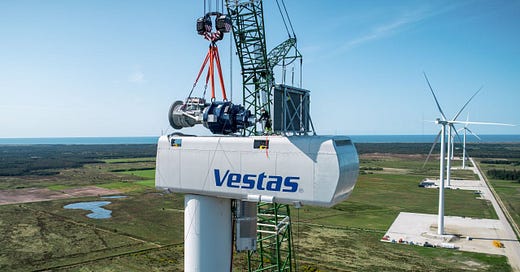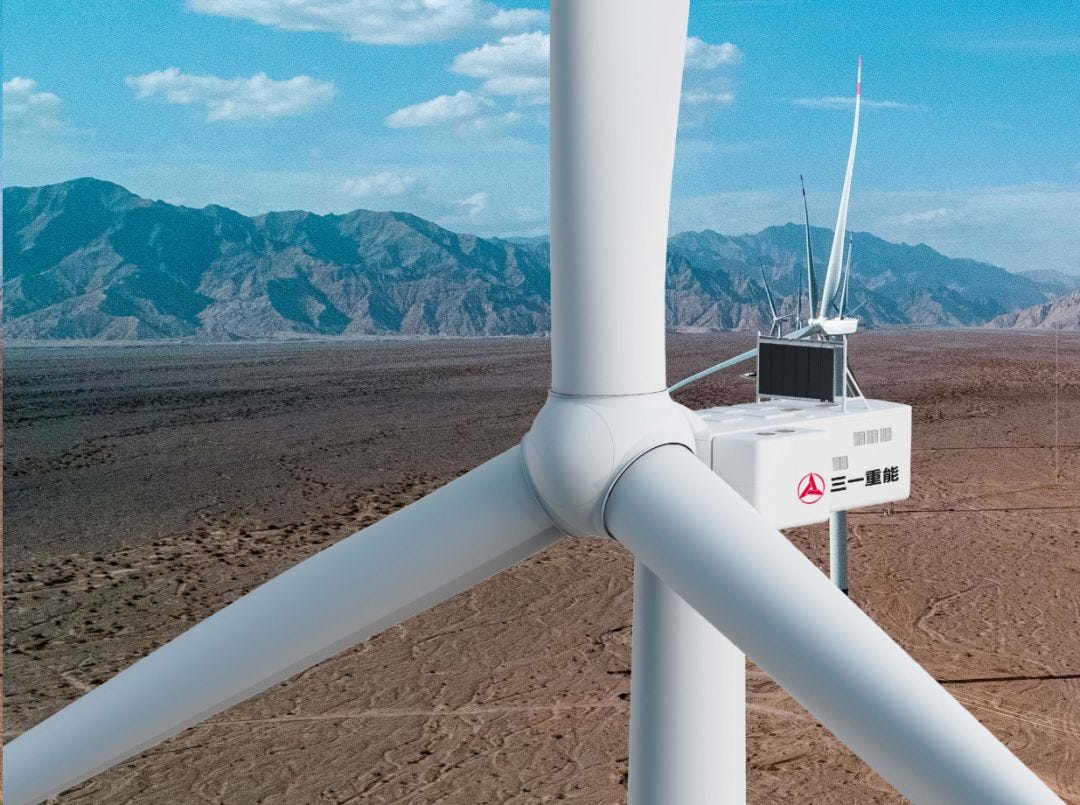Windletter #68 - The best wind turbines and innovations of 2023
Also: closure of Deutsche Windtechnik España, the world's largest onshore blade, offshore wind auction in Spain, foundations with prefabricated braces, and more.
Hello everyone and welcome to a new issue of Windletter. I'm Sergio Fernández Munguía (@Sergio_FerMun) and here we discuss the latest news in the wind power sector from a different perspective. If you enjoy the newsletter and are not subscribed, you can do so here.
The most read from the last edition has been: the article about the great correction of Hywind Scotland, the video about the communication approach in energy transition, my article on Xataka about alternative uses of recycled blades..
Let's go with the news of the week.
Wind turbines of the year according to Windpowermonthly
Annually, the specialized publication Windpowermonthly celebrates the Wind Turbines of the Year awards. They are probably the most prestigious awards in the sector and serve to provide an overview of what is happening in the industry in terms of new models, technological innovations, etc.
They are behind a paywall, but the different awardees gradually share their medals on social media, allowing us to review the various categories and winners.
Onshore
< 5.6 MW: Vestas V163-4.5 MW. Vestas' 4 MW platform remains in top form. Following the success of the V150-4.2 MW, Vestas introduced the "high capacity factor" variant, especially designed for locations with medium to low winds. This turbine is expected to be a success in the United States (as demonstrated by the 1.1 GW SunZia project), but it has also secured a contract in Spain, for example.
My impression is that Vestas continues to give a lot of prominence to the 4 MW platform in onshore, even ahead of the EnVentus platform, which starts from 6 MW. The 4 MW platform is a wind turbine with an asynchronous generator and a full converter. More information can be found on Vestas' LinkedIn.
> 5.6 MW: Sany SI-230-100. The 919-series platform from Sany has been the winner in the onshore category for turbines over 5.6 MW. This platform was launched at WindEnergy Hamburg in 2022.
The SI-230-100 has been the model receiving the award, but the platform has a variable power ranging from 8.X to 11.X MW and rotor sizes of 214 and 230 meters depending on the wind type. Additionally, it has an offshore variant.
It is a doubly fed induction generator (DFIG) machine, probably the most powerful in the world using this technology. More information can be found on Sany's LinkedIn.
Chinese manufacturers have been some of the major winners of these awards. It makes sense because they are currently the most active in terms of introducing new models.
Offshore
The winner in the offshore category is the Mingyang MySE 18-292, currently one of the most powerful wind turbines ever manufactured, boasting 18 MW and featuring the industry's largest rotor at 292 meters.
The first nacelle of this unit is already manufactured and should be ready for installation or already installed. This will be the first prototype of Mingyang's new platform, ranging from 18 to 22 MW, and including the largest wind turbine ever presented: MySE 22-310 (22 MW, 310 meters rotor).
Technologically, the platform features a fully integrated drive train, meaning both the gearbox (at medium speed) and generator are housed in the same frame. The generator is of permanent magnet type, and it employs a full converter. More information can be found on Mingyang's LinkedIn.
Drive train
The award for the best powertrain or drive train goes to the Enercon E-175 EP5 E2. This machine is the evolution of the E-175 EP5, incorporating some technological improvements.
The main enhancement is in the generator, which is divided into two parts to improve logistics, probably because transporting the complete disc implies many challenges (or is simply not possible due to diameter limitations) in many markets. In fact, it has always been noted that one of the limitations of Direct Drive technology onshore was the transportation of the generator.
Another change that this generator has undergone is that it now features an external rotor, meaning the rotor rotates outside around the stator, unlike the usual arrangement where it is the other way around. More information can be found on Enercon's LinkedIn.
Best Innovation
The best innovation award goes to a pitch system designed by Thyssenkrupp Rothe Erde, intended for the next generation of onshore wind turbines >7MW and offshore wind turbines >10MW. I don't have much to add here, as these topics are beyond my knowledge. More information can be found on Thyssenkrupp Rothe Erde's LinkedIn.
By the way, the second prize went to Vestas' guyed rotor, which we have discussed here before.
Someday we will have the 'Wind Turbines of the Year according to Windletter', 😂 so subscribe if you don't want to miss it! 👇
_
Deutsche Windtechnik Spain, in bankruptcy proceedings
I was very surprised by this news that comes from Diego Botero, General Manager of Deutsche Windtechnik España. According to his LinkedIn profile, the Spanish division of this giant in wind turbine O&M provider is currently undergoing bankruptcy proceedings.
For those unfamiliar, Deutsche Windtechnik is one of the leading independent providers of operation and maintenance services for wind farms worldwide, what is known in the industry jargon as Independent Service Provider (ISP).
This 2020 news speaks of an impressive 10 GW under maintenance worldwide. On their website, they mention figures like 7,186 wind turbines under maintenance and 2,255 employees.
I did some research to understand the origins of this division in Spain and had to go back to 2014 when the parent company of Deutsche Windtechnik acquired the Spanish company General Power Services.
Since then, there have been successive news about contracts won, especially for Gamesa technology ranging from G42 to G114, eventually reaching up to 1 GW in maintenance in Spain for all technologies.
And what could have happened? There isn't much information available on the internet, so it's hard to say. If more information is revealed, we will report it here.
Interestingly, the Spanish division is not even mentioned on the global website anymore.
_
Goldwind delivers components of the GW165-6.0 MW in South Africa
Chinese manufacturers continue their international expansion, and while the markets in Europe and the United States are still challenging for them, they are gaining numerous contracts in other regions, such as Africa.
This time, we have news from Goldwind regarding the transportation of blades for the GW165-6.0 MW for the Castle Wind Farm project in South Africa. Although this isn't the first time the manufacturer has installed turbines in the country.
The project consists of 16 units, totaling 96 MW.
_
Sany manufactures the world's largest onshore wind turbine blade
Returning to Sany, if you thought the Sany SI-230-100 mentioned above was large enough, for the Chinese manufacturer, it's not. As announced on their LinkedIn account, they have just manufactured the now world's largest onshore wind turbine blade.
We are talking about a blade that measures an impressive 131 meters in length, which is now undergoing a demanding testing phase. You can find some of the technological advancements that Sany has included in this blade on their LinkedIn post.
However, it's important to note that these types of wind turbines are highly specific to certain areas of the Chinese market, with factories nearby and transportation facilities. In general, except for specific cases, they may not be suitable for other countries where such large blades (and corresponding towers, probably) cannot be transported by road unless segmented.
Remember that Sany is in the midst of international expansion and is reportedly on the verge of closing its first contract in Germany for 2 wind turbines of 10 MW each.
There have also been discussions about opening factories in Europe. Sany's representative for Europe, Haijun Deng, stated to Recharge that they are working to build a wind turbine factory with an annual capacity of 1 GW. He mentioned Germany as the primary location, with Spain and Turkey as the main alternatives.
_
Transport trucks carrying wind turbine blades blocked on Spanish roads
Six trucks transporting wind turbine blades became stuck in Piedrafita as they were unable to pass through the viaduct on the A-6, at the border between El Bierzo and Galicia.
The blades where coming from the LM factory in Castellón and were destined for the port of Ferrol to be shipped to the United States. The entire issue stemmed from the collapse of the O Castro viaduct in June 2022, which has restricted traffic until the completion of reconstruction.
Eventually, the trucks were able to continue their journey with a special permit granted for the occasion.
_
Visualizing the construction data of Dogger Bank A
I have to admit that I love the things that can be done in the world of data visualization. And when it comes to data visualization and wind energy, the best is Robin Hawkes.
One of his recent projects has been visualizing the logistics of the construction of Dogger Bank A. The video allows you to see the movements of the vessels and also how the construction progress is unfolding.
It is still a preliminary version that Robin promises to continue improving.
You can view it at this link; it's worth checking out.
_
The Spanish offshore wind auction moves forward with delays
We are already in February, and there is still no clear news about the guidelines for the first Spanish offshore wind auction.
According to Sandra Acosta in El Periódico de la Energía, the Ministry is finalizing work on the Royal Decree Law and intends to release this document for public consultation 'soon.'
In theory, the regulatory framework should have been released for public consultation before the end of 2023, but it has not happened yet.
As mentioned here before, the Canary Islands are likely to be the location for the auction, specifically Gran Canaria.
This makes sense in terms of cost, as generating electricity is more expensive on the islands, making an offshore wind farm more easily justifiable than on the mainland Spain. This has been also publicly discussed by Canarian political leaders in recent months.
More information available in Windletter #59.
_
Prefabricated braced foundations
The curiosity of the week comes from Charles Phillips on LinkedIn and the Dumat Al Jandal wind farm, the first in Saudi Arabia.
Key details:
Location: Saudi Arabia
Owners: EDF and Masdar
Wind turbines: 99 x Vestas V150-4.2 MW
Nominal capacity: 400 MW
Commissioned: 2021
The most surprising aspect of this wind farm is undoubtedly its tariff or feed-in tariff, which is only $19.9 per MWh, probably one of the lowest in the world.
But the most curious aspect is undoubtedly its foundations.
In the photo, you can see what is called a foundation with prefabricated braces.
Although prefabricated foundations have been attempted several times, it has never quite succeeded since it is challenging to justify unless on-site concrete is very expensive or simply impossible.
So, this foundation design has only been used in a few wind farms worldwide.
For those interested in more information, this post by Francesco Miceli on his Wind Farm BOP website is very informative, as well as this paper by Esteyco.
Thank you very much for reading Windletter. If you enjoyed it, I invite you to subscribe, leave a ❤️, forward it by email, share it on social media, or recommend it to others.
You can follow Windletter's profiles on Twitter and LinkedIn. Also, if you enjoy reading about energy, check out Windletter's Library.
You can also contact me through my Twitter or LinkedIn profiles.
See you in the next one!
Disclaimer: The opinions presented in Windletter are mine and do not necessarily reflect the views of my employer.












